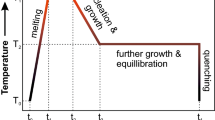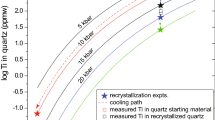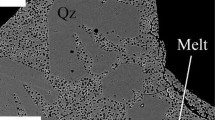Abstract
The dominant hydrogen impurity in synthetic quartz is molecular H2O. H-OH groups also occur, but there is no direct evidence for the hydrolysis of Si-O-Si bonds to yield Si-OH HO-Si groups. Molecular H2O concentrations in the synthetic quartz crystals studied range from less than 10 to 3,300 ppm (H/Si), and decrease smoothly by up to an order of magnitude with distance away from the seed. OH− concentrations range from 96 to 715 ppm, and rise smoothly with distance away from the seed by up to a factor of three. The observed OH− is probably all associated with cationic impurities, as in natural quartz. Molecular H2O is the dominant initial hydrogen impurity in weak quartz. The hydrolytic weakening of quartz may be caused by the transformation H2O + Si-O-Si → 2SiOH, but this may be a transitory change with the SiOH groups recombining to form H2O, and the average SiOH concentration remaining very low. Synthetic quartz is strengthened when the H2O is accumulated into fluid inclusions and cannot react with the quartz framework.
Similar content being viewed by others
References
Aines RD, Rossman GR (1984a) Water in minerals? A peak in the infrared. J Geophys Res 89:4059–4072
Aines RD, Rossman GR (1984b) The hydrous component in garnets. I. Pyralspites. Am Min (in press)
Bartholomew RF, Butler BL, Hoover HL, Wu CK (1980) Infrared spectra of a water containing glass. J Am Cer Soc 63:481–485
Dodd DM, Fraser DB (1965) The 3000–3900 cm−1 absorption bands and anelasticity in crystalline quartz. J Phys Chem Solids 26:673–686
Dodd DM, Fraser DB (1967) Infrared studies of the variation of H-bonded OH in synthetic alpha-quartz. Am Min 52:149–160
Finkelman RB, Evans HT Jr, Matzko JJ (1974) Manganese minerals in geodes from Chihuahua, Mexico. Min Mag 39:549–558
Flörke OW, Köhler-Herbertz B, Langer K, Tönges I (1982) Water in microcrystalline quartz of volcanic origin: agates. Contrib Mineral Petrol 80:324–333
Freiman SW (1984) Effects of chemical environments on slow crack growth in glasses and ceramics. J Geophys Res 89:4072–4076
Frondel C (1982) Structural hydroxyl in chalcedony (Type B quartz). Am Min 67:1248–1257
Goldman DS, Rossman GR, Dollase WA (1977) Channel constituents in cordierite. Am Min 62:1144–1157
Griggs DT (1974) A model of hydrolytic weakening in quartz. J Geophys Res 79:1653–1661
Griggs DT, Blacic JD (1965) Quartz: anomalous weakness of synthetic crystals. Science 147:292–295
Hobbs BE (1984) Point defect chemistry of minerals under a hydrothermal environment. J Geophys Res 89:4026–4038
Kats A (1962) Hydrogen in alpha-quartz. Philips Res Rep 17:133–279
Kekulawala KRSS, Paterson MS, Boland JW (1981) An experimental study of the role of water in quartz deformation. In: Carter NL et al. (eds) Mechanical Behavior of Crustal Rocks, The Handin Volume, Geophysical Monograph 24, American Geophysical Union, pp 49–60
Kirby SH, McCormick JW (1979) Creep of hydrolytically weakened synthetic quartz crystals oriented to promote \({\text{\{ 2}}\overline {{\text{11}}} {\text{0\} }}\) <0001> slip: a brief summary of work to date. Bull Miner 102:124–137
Kirby SH (1984) Hydrogen-bonded hydroxyl in synthetic quartz: analysis, mode of incorporation and role in hydrolytic weakening. Submitted to Phys Chem Min
Langer K, Flörke OW (1974) Near infrared absorption spectra (4,000–9,000 cm−1) of opals and the role of “water” in these SiO2·nH2O minerals. Fortschr Mineral 52:17–51
Laudise RA (1959) Kinetics of hydrothermal quartz crystallization. J Am Chem Soc 81:562–566
Laudise RA (1973) Hydrothermal growth. In: Crystal Growth, an Introduction. Hartman P (ed) North Holland, Amsterdam, pp 162–197
McLaren AC, Cook RF, Hyde ST, Tobin RC (1983) The mechanisms of the formation and growth of water bubbles and associated dislocation loops in synthetic quartz. Phys Chem Min 9:79–94
Nuttall THD, Weil JA (1980) Two hydrogenic trapped-hole species in α-quartz. Solid State Commun 33, 99–102
Scholze H (1960) Zur Frage der Unterscheidung zwischen H2O-Molekülen und OH-Gruppen in Gläsern und Mineralien Naturwissenschaften 47:226–227
Stolper EM (1982) Water in silicate glasses: an infrared spectroscopic study. Contrib Mineral Petrol 81:1–17
Stone JG, Walrafren GE (1982) Overtone vibrations of OH groups in fused silica optical fibers. J Chem Phys 76:1712–1727
Van Thiel M, Becker ED, Pimental GC (1957) Infrared studies of hydrogen bonding of water by the matrix isolation technique. J Chem Phys 27:486–490
Author information
Authors and Affiliations
Rights and permissions
About this article
Cite this article
Aines, R.D., Kirby, S.H. & Rossman, G.R. Hydrogen speciation in synthetic quartz. Phys Chem Minerals 11, 204–212 (1984). https://doi.org/10.1007/BF00308135
Received:
Issue Date:
DOI: https://doi.org/10.1007/BF00308135




